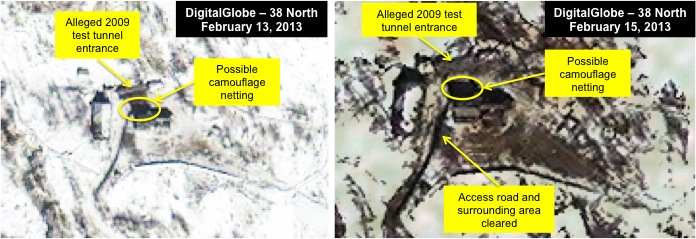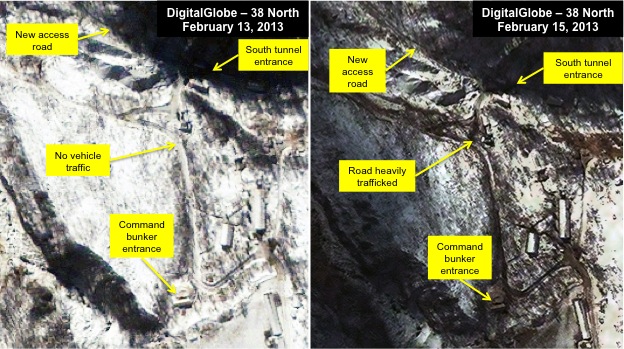Post-Test Analysis of Punggye-ri: What a Difference a Few Days Make
Commercial satellite imagery of the Punggye-ri Nuclear Test Facility taken at intervals of one and three days after North Korea’s third nuclear detonation provides an interesting glimpse of the post-test activity. Press reports indicated that the test site had been evacuated on February 8. While there was no visible vehicular or human movement in the area one day after the blast, perhaps to ensure that the levels of radioactivity at the site were safe, the area was active by February 15. (Some of the differences between the two images may also be the result of melting snow that had fallen on February 13.)
It remains unclear whether renewed activity at the site is normal for the days after a nuclear detonation or if it is an indication of Pyongyang’s intention to conduct another test in the near future. It is also unclear whether Pyongyang will be in a position to conduct such a test. If a second tunnel at the northern area (West Portal) was used to conduct the third nuclear detonation as some suspect, and this is not yet proven, then the southern tunnel would be readily available for a fourth test.
Overview of the Test Site
Satellite imagery taken on January 28, 2013, provides an overview of the principal features of the test facility (figure 1). To the north is the Northern Building Complex, also referred to as the West Portal. It is believed to contain the tunnel entrance for the 2009 test. Starting in December 2012, this area has seen considerable activity.
Figure 1. Punggye-ri Nuclear Test Facility North and South Areas

At the center of the facility is the Administration and Staging Area that has also been quite active since December 2012, when evidence of activity was visible in the form of vehicular and foot traffic as well as the emplacement of various vehicles and small structures.
The South Tunnel entrance has been the topic of much discussion over the past year, with a new access road bypassing the old road damaged by flooding six months ago, and a newly cleared area whose purpose still remains unclear but may be the initial construction of a new tunnel.
Test Day and Three Days After
North Korea’s third nuclear test occurred at 02:57:51 UTC on February 12, 2013, producing a measured 5.1 magnitude seismic shock that some sources say is equivalent to 6-7 kilotons of TNT. The epicenter of the test was estimated by United States Geological Survey (USGS) to be at 41.301 N, 129.081 E, some 3.5 km north of the center of the test facility. Since that estimate is imprecise—the actual location of the epicenter can be anywhere within 10 km of this point—it is not possible to say with this data alone whether the South Tunnel or some other area was used for the test.
While there appeared to be no activity at the Punggye-ri facility the day after the detonation, by two days later, there had been traffic (figure 2). The Feb 13 image, taken about 24 hours after the test, shows no evidence of vehicular or human movement at the site. By February 15, there were signs of traffic. For safety reasons, on the first day, personnel at the test site probably focused on remotely monitoring local radiation levels, until it was verified that those levels were acceptable. Moreover, there is no evidence that a tunnel entrance was breeched by the blast, consistent with the reports of no detectable radiation released after the test.
Figure 2. No activity one day after the test; a different story three days later.

At the Northern Building Complex (West Portal) there is no evidence of activity a day after the test but by February 15, the access road and surrounding area appear to have been cleared, although some of the change may also be due to melting snow. The possible camouflage netting covering activity near the alleged tunnel entrance for the 2009 test is visible. There is speculation that this may also be the entrance to another tunnel where the latest test was conducted, but imagery cannot confirm such speculation. It does indicate that there is a great deal of activity; and the possible camouflage netting may be used to conceal some related movements.
Figure 3. Activity at the Northern (West) area.

Most of the activity three days after the test appears to be concentrated in the Administration and Staging Area (figure 4). The road is clear and shows signs of heavy usage. The concentration of foot patterns at specific buildings provides a further indication of movement. One possible explanation is that, if the test was conducted at this location, these buildings may contain the bulk of the equipment for recording data, and the facility personnel may have been engaged in retrieving that information.
Figure 4. Activity at the Administration and Staging Area.

As for the South Tunnel entrance, once again, while there was little or no activity a day after the detonation, by February 15 there were clear signs of movement (figure 5). There was no vehicular traffic along the access road south to the town of Punggye-ri on February 13. An image from February 15 shows that there had been traffic on the road, supporting the possibility that many facility personnel had moved back to the site. If the Southern Tunnel was the location of the detonation, once again movement may have been to recover recorded data as well as to perform maintenance and cleanup. In any case, the tunnel entrance appears to have been cleared of snow although a deep shadow on both days precludes any detailed analysis.
Figure 5. Activity around the South Tunnel.

Conclusion
Based on available data, it is impossible to pinpoint the exact location and tunnel used for North Korea’s third nuclear test. Satellite imagery from 24 and 72 hours after the test—taken on February 13and 15, show no evidence of a containment breech anywhere on the facility, making identification of the tunnel used even more difficult while also possibly indicating that the nuclear detonation was well contained. Press reports about the failure of sniffer aircraft deployed to detect radioactive decay products supports such a conclusion. Data gathered by those aircraft would have helped determine whether the test device was plutonium or highly enriched uranium, an important issue in pinpointing the DPRK’s progress in producing highly enriched uranium. However, the air sample would have had to be within 10 hours of the detonation before deterioration of the radioactive elements would have made it impossible to gather useful information.[1]
The difference in activity between February 13 and 15 is nevertheless noteworthy. It may indicate that the DPRK took safety precautions to ensure radioactivity levels were sufficiently low before sending personnel back into the area. North Korean monitoring may have been done remotely initially and by February 15 personnel returned in earnest.
It remains unclear whether renewed activity at the site is normal for the days after a nuclear detonation or if it is an indication of Pyongyang’s intention to conduct another test in the near future. It is also unclear whether Pyongyang will be in a position to conduct another nuclear test in the near future. If a second tunnel at the Northern area/west portal was used to conduct the third nuclear detonation, and this is not yet proven, then the Southern tunnel would be readily available for a fourth test.
[1] An article on February 19, 2013 reported that radioactive isotope xenon-133 had been detected at the Punggye-ri nuclear test site on February 15. However, the detection was still too late to determine if the device was plutonium or highly enriched uranium.
